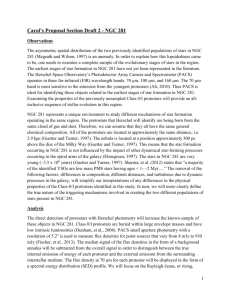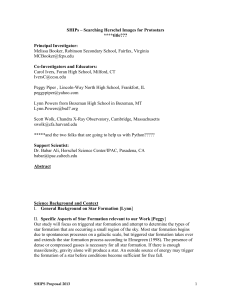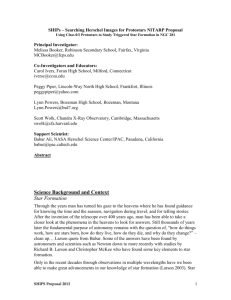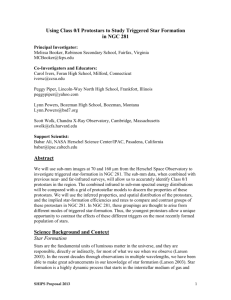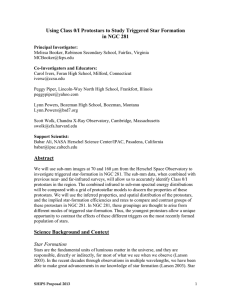SHIPS_Proposal_v03_03b
advertisement
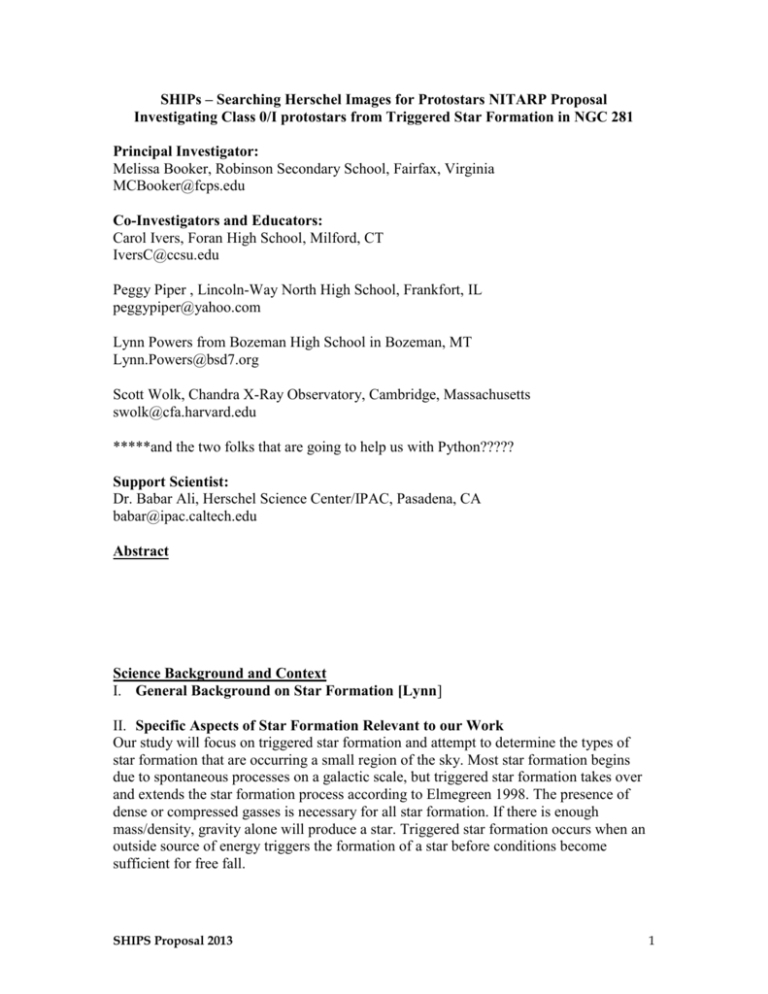
SHIPs – Searching Herschel Images for Protostars NITARP Proposal Investigating Class 0/I protostars from Triggered Star Formation in NGC 281 Principal Investigator: Melissa Booker, Robinson Secondary School, Fairfax, Virginia MCBooker@fcps.edu Co-Investigators and Educators: Carol Ivers, Foran High School, Milford, CT IversC@ccsu.edu Peggy Piper , Lincoln-Way North High School, Frankfort, IL peggypiper@yahoo.com Lynn Powers from Bozeman High School in Bozeman, MT Lynn.Powers@bsd7.org Scott Wolk, Chandra X-Ray Observatory, Cambridge, Massachusetts swolk@cfa.harvard.edu *****and the two folks that are going to help us with Python????? Support Scientist: Dr. Babar Ali, Herschel Science Center/IPAC, Pasadena, CA babar@ipac.caltech.edu Abstract Science Background and Context I. General Background on Star Formation [Lynn] II. Specific Aspects of Star Formation Relevant to our Work Our study will focus on triggered star formation and attempt to determine the types of star formation that are occurring a small region of the sky. Most star formation begins due to spontaneous processes on a galactic scale, but triggered star formation takes over and extends the star formation process according to Elmegreen 1998. The presence of dense or compressed gasses is necessary for all star formation. If there is enough mass/density, gravity alone will produce a star. Triggered star formation occurs when an outside source of energy triggers the formation of a star before conditions become sufficient for free fall. SHIPS Proposal 2013 1 Observations of types of triggering are organized into three categories; small scale triggering which consists squeezing areas of density from all sides intermediate scale triggering which consists of pressure from one direction that moves through an existing area of density creating a wave front of increased density that produces stars, Figure ? Schematic from Elmegreen (1998) showing clumps being squeezed to produce protostars sequentially younger stars are produced as the front moves further from the pressure source large scale triggering which consists of an expanding H II region around a massive star colliding with surrounding gasses producing a ring or shell of density and star formation Elmegreen (2008) describes three morphologies produced during the process of pressure induced triggering. Individual high pressure clumps or protostars A high pressure clump or protostar with a cometary or elephant trunk tail trailing away from the pressure source. Bright rims of increased density and star formation along the pressure front The physical and sequential distribution of protostars within various structures is dependent on the type of triggering mechanism along with factors such as chemical makeup, internal motion, turbulence, magnetic waves, fragmentations, heating and cooling ionization. Magnetic fields in particular may affect the morphology in a star forming region by producing filaments of density. Stars produced in filaments, regardless of the process, will be segregated geographically. One way of eliminating some of the many variables affecting distribution of protostars is to focus on a small region of star formation. Small regions in close proximity formed under very similar if not identical circumstances hold constant many of the possible variables in an almost “controlled environment”. The processes by which protostars were created in these regions can then be considered where the physical and/or age distribution vary and multiple processes identified if they exist. Evans et al. 2009 chose to study star formation in five nearby molecular clouds based on their similarities in their study “from molecular cores to planet forming disks” (abbreviated c2d) using primarily Spitzer data. The slope of SEDs, bolometric temperature, and color-color diagrams were used to determine class. Criteria for this SHIPS Proposal 2013 2 study only allowed for protostars that were detected in all Spitzer IRAC bands (3.6 – 8.0 micron) and Spitzer MIPS 20 micron and showing an infrared excess resulting in young stars through Class II and the beginning stages of Class III as infrared excess diminishes in Class III. This method also misses the youngest stars that are deeply embedded, with the majority of their emissions coming from their dense cloud at much longer wavelengths. In our proposed study, Herschel data will see the dust of the youngest stars clearly at longer wavelengths allowing us to better identify Class 0 and Class I stars. Star Formation Rate (SFR), a measure of mass per unit time, was then used in the c2d study along with class determination to calculate an estimation of how much time stars spent in each of these classes. Further calculations of Star Formation Efficiencies (SFE), a ratio of the mass of the protostars to the total mass of the cloud, and star depletion time (tdep) were also made. Associations between classes and physical distribution within the clouds showed the youngest objects to be in the densest clusters in areas of high extinction with older stars having dispersed over time as seen in figure ??. were also considered. We will use these same or similar methods in our proposed study on a region that has even tighter “controlled environment” allowing us to compare SFR, SFE, tdep, physical and age distribution of different clumps within the same star forming region but with the advantage of being able to “see” the youngest protostrars using Herschel. Figure ? Location of youngest to oldest protostars (red, green, blue, violet in terms of increasing age) on an extinction map of clouds studied by Evans et al (2009) III. Our Target: NGC 281 The target of our research is NGC 281, an active star-forming nebulosity about 2.81± 0.24 kpc or 9200 light-years away (Sato et al. 2008) at a relatively high galactic latitude (2000=00h52m, 2000=+5634or l=123.1, b= -6.3) in the constellation Cassiopeia (Figure ). NGC 281 contains several distinct regions (Figure ): An HII emission region Sharpless 184 of diameter 20 arcminutes containing the young galactic cluster IC 1590 centered about the OB star trapezium system HD5005 (Guetter & Turner 1997). SHIPS Proposal 2013 3 Lynn: Figure The location of NGC 281. reference? I took this from the Wiki Two quite distinct CO molecular clouds (Elmegreen & Lada 1978): o The southeastern CO region (N281A) with local standard of rest (LSR) similar to that of the HII region itself (-30.5 kms-1 vs. -26.5 kms-1 Leisawitz 1988). This region contains highly recognizable “pillars of creation,” the pillars contain bright rimmed globules left after much of the rest of the molecular cloud has been photoevaporated (reference). Figure . NGC 281 as seen in X-ray and infrared. Credit: Xray: NASA/CXC/CfA/S.Wolk; IR: NASA/JPL/CfA/S. Wolk o NGC 281 West (N281B), a molecular cloud in the southwestern region with three distinct clumps (NE, NW, and S) (Megeath & Wilson 1997). The region is heavily obscured by dust (Guetter & Turner 1997) and has a LSR (+44 kms-1) quite different from that of its eastern neighbor and the HII region it borders (Leisawitz 1988) Stars in IC 1590 The young, galactic cluster IC 1590 has 63 identified probable members (Guetter & Turner 1997). Twentytwo of the 63 stars are identified as pre-main sequence and show evidence of gravitational contraction (Guetter & Turner 1997). This further supports the evidence for the extreme youth of the cluster and its central trapezium system, HD 5005 which has four fairly hot, young main sequence OB stars (Guetter & Turner 1997). Color-magnitude diagrams of IC 1590 indicate main sequence stars of spectral types O6.5 to B9.5 and premain sequence stars of spectral types A8/9 to G8 (Guetter & Turner 1997) (Figure ). [Say something about the OB stars emitting UV radiation and stellar shocks] Fig . Reddening corrected color-magnitude diagram for likely members of IC 1590. The continuous line represents the ZAMS. The red circle indicates the main sequence OB stars. The blue circle indicates the pre-main sequence stars in the cluster. Credit: Guetter & Wilson 1997 [Colored circles were added for emphasis] Interaction between the OB stars and the molecular clouds The UV radiation and stellar shocks from the trapezium may very well be triggering star formation in the molecular clouds in NGC 281 West (Megeath & Wilson 1997). Thus, the NGC 281 region will provide “…an excellent laboratory for studying in detail star formation through the interaction of high mass stars with their surrounding cloud” SHIPS Proposal 2013 4 (Sharma et al. 2012) and studying “…the propagation of an ionization front into a clumpy molecular cloud and its effect on star formation” (Megeath & Wilson 1997). Because the pre-main sequence stars detected in IC 1590 have very little variability, Guetter & Turner (1997) suggest that a survey of the nearby class 0, I, II and III embedded protostars should reveal “cluster members of that type.” Indeed, Guetter & Turner further suggest that “…much information related to the star formation process could be obtained by imaging the field to fainter magnitude limits.” At the time of Guetter & Turner’s paper, far-infrared imaging was not practical. The far-infrared (FIR) wavelength bands of the Hershel Space Observatory at 70m, 100m, and 160m are ideal for detecting the class 0 and I stars as suggested by Guetter & Turner. Evidence for Triggered Star Formation in NGC 281 The Megeath & Wilson (1997) radio and near-infrared studies of the 3 clumps (see figure ) in the molecular cloud of NGC 281 West near the HII/molecular cloud interface provide a deduction of the kinematic behavior in the clumps in the molecular cloud. These studies indicated that the kinetic and gravitational energy of the clumps appear to be approximately equal indicating that the clumps are not strongly gravitationally bound. This indicates that some other mechanism is confining the clumps. Megeath & Wilson suggest that the confinement of the clumps may be provided by external pressure (possibly from photoionized gas at the clump surface) or shock compression. VLA 20 cm imaging by Megeath & Wilson (1997) of the clumps in NGC 281 West indicates emission from ionized gases at the northern edge of each of the three clumps. This supports the proposal Figure. Velocity integrated intensity line maps. The C18O (1-0) and that all three clumps are exposed to the UV C18O (2-1) maps show molecular gas is concentrated in three clumps radiation from the O-type stars in the which Megeath & Wilson (1997) denote NE, NW, and S. Credit: HD5005 trapezium. Megeath & Wilson 1997 The clumps in NGC 281 West exhibit complex kinematical structures which may be the result of shocks (Megeath & Wilson 1997). Observed velocity structures in the clumps can be explained and are consistent with models of radiation driven implosions (RDIs). Results from Megeath & Wilson (1997) suggest that the dense gas traced by C34S (32) in NGC 281 West may have resulted from compression from RDIs. SHIPS Proposal 2013 5 K’ band imaging of the northern and southern clumps in NGC 281 West shows an asymmetry in the distribution of the low mass stars in these clumps. There is a large concentration of stars near the northern edge of the NE and NW clumps and very few stars on the southern edges of the clumps. Megeath & Wilson suggest that since the stars in the NW and NE clumps are concentrated on the edges of the clumps facing the OB group (see figure ), it is “…likely that the asymmetrical distribution of stars is the results of photoionization of the clumps.” Evidence of ongoing shocks in the clumps suggest that shock triggered star formation is the best explanation for asymmetry in star distribution in the clumps (Megeath & Wilson 1997). Here again we suggest that the FIR wavelength bands of the Hershel are ideal for detecting the class 0/I protostars in the NE and NW clumps of NGC 281 West. Figure . The deep K’ band image of the northern subcluster with the velocity integrated C18O (2-1) contour map overlayed. Notice how the stars are concentrated in the northern halves of the two clumps. Credit: Megeath & Wilson 1997 IV. How will we observe our target and what specific properties of NGC 281 will we analyze? Observations The asymmetric spatial distribution of the two previously identified populations of stars in NGC 281 (Megeath & Wilson 1997) is an anomaly. In order to explain how this lopsidedness came to be, one needs to examine a complete sample of the evolutionary stages of stars in the region. The earliest stages of star formation in NGC 281 have not yet been represented in the literature. The Herschel Space Observatory’s Photodetector Array Camera and Spectrometer (PACS) operates in three far-infrared (FIR) wavelength bands: 70 µm, 100 µm, and 160 µm. The 70 µm band is most sensitive to the emission from the youngest protostars (Ali 2010). Thus PACS is ideal for identifying those objects related to the earliest stages of star formation in NGC 281. Examining the properties of the previously unsampled Class 0/I protostars will provide an all-inclusive sequence of stellar evolution in this region. NGC 281 represents a unique environment to study different mechanisms of star formation operating in the same region. The protostars that Herschel will identify are being born from the same cloud of gas and dust. Therefore, we can assume that they all have the same general chemical composition. All of the protostars are located at approximately the same distance, i.e. 2.9 kpc (Guetter & Turner, 1997). The nebula is located at a position approximately 300 pc above the disc of the Milky Way (Guetter & Turner 1997). This means that the star formation occurring in NGC 281 is not influenced SHIPS Proposal 2013 6 by the impact of other dynamical star-forming processes occurring in the spiral arms of the galaxy (Elmegreen 1997). The stars in NGC 281 are very young (~3.5 x 106 years) (Guetter & Turner 1997). Sharma, et al. (2012) states that “a majority of the identified YSOs are low mass PMS stars having ages < 1- ~2 Myr….” The removal of the following factors: differences in composition, different distances, and turbulence due to dynamic processes in the galaxy, will simplify our interpretations of any differences in the physical properties of the Class 0/I protostars identified in this study. In turn, we will more clearly define the true nature of the two different populations of stars present in NGC 281. Analysis The direct detection of protostars with Herschel photometry will increase the known sample of these objects in NGC 281. Class 0/I protostars are buried within large envelope masses and have low intrinsic luminosities (Dunham et al. 2008). PACS small aperture photometry with a resolution of 5.2″ is used to measure flux densities for point sources that vary from 8 mJy to 930 mJy (Fischer et al. 2013). The median signal of the flux densities in the form of a background annulus will be subtracted from the overall signal in order to distinguish between the true internal emission of energy of each protostar and the external emission from the surrounding interstellar medium. The flux density at 70 µm for each protostar will be displayed in the form of a spectral energy distribution (SED) profile. We will focus on the Rayleigh-Jeans, or rising, portion of each SED as this is where the emission from Class 0 protostars peaks (Rebull 2012). Class I protostars display SEDs that flatten after the peak (Rebull 2012). SEDs profiles and the derived internal luminosities will be used to constrain the envelope mass, and thus the classification, of each protostar. SHIPS Proposal 2013 7 Figure . Model SED with peak at 70 µm and protostar geometry Credit: <http://coolwiki.ipac.caltech.edu/images/a/ae/Model_pars.png> A previously defined grid of radiative transfer models, generated with the Monte Carlo code of Whitney, et al. (2003), was constructed by Fischer, et al. (2013). This grid is built on the physical characteristics of protostars, i.e. envelope densities, cavity opening angles, overall inclinations, and internal luminosities. This same approach will be used here to constrain the physical properties and varied geometry of the newly identified Class 0/I objects in our sample. (See figure below.) Similarities and differences in SED models of embedded Class 0/I protostars in NGC 281 will allow us to discern any physical differences between the two populations of protostars that exist in the region. Dunham, et al. (2008) state that the value for the internal luminosity of an embedded protostar is not “a directly observable quantity” but that it is “tightly correlated with the 70 µm flux”. Bolometric luminosity (Lbol) “is calculated by integrating over the full SED” (Dunham, et al. 2008). Bolometric temperature (Tbol) is defined as “the temperature of a blackbody with the same flux-weighted mean frequency as the source (Meyers & Ladd 1993). Similar to the approach of Evans, et al. (2008), we will use bolometric luminosity-temperature (BLT) diagrams to constrain the evolutionary stages of the embedded Class 0/I protostars in NGC 281. (See figure ) Figure . Model SED with peak at 70 µm and protostar geometry Credit: Young & Evans 2005 SHIPS Proposal 2013 8 Dunham, et al. (2008) state that the data for embedded protostars in previous studies does not agree well with evolutionary models based on mass accretion rates. BLT diagrams for protostars in NGC 281 will add further evidence to test the validity of these models. Analysis Plan Education and Outreach Team Foran High School (C. Ivers): Both high school and college students from different towns in CT will participate in the NITARP-based SHIPS research project as an extra-curricular-independent study. The students involved will be required to investigate all concepts and diagnostic tools used to gain an understanding of the formation, birth, and evolution of stars. These topics will be discussed at weekly meetings and will mirror the learning taking place for teachers during weekly teleconferences. Students will be required to teach a portion of what they have already learned at each session. Data processing and analysis is a major portion of the student contribution to the project, so all students involved will learn to use the programming language Python. Educational outreach will involve teacher and student presentations within the local school district for other educators and students as well as for other area astronomy groups and colleges. Team Robinson Secondary (M. Booker): Six high school sophomores and juniors from Robinson Secondary will be offered the opportunity to participate in the NITARP-based SHIPs research project as an extra-curricular independent study. The students involved will be required to investigate all concepts and diagnostic tools used to gain an understanding of the formation, birth, and evolution of stars. The student research team will meet once a week to discuss astronomy concepts related to the study of protostars development. At the meetings students may be (1) learning new concepts through active learning experience, (2) learning to use the data analysis tools of the reach (e.g. DS9, APT, and Python programming), (3) engaging in discussions on current research, or (4) performing data analysis using the tools listed previously. Educational outreach will include a talk or workshop at one of the Fairfax County Public Schools in-services, at a Virginia Association of Science Teachers (VAST) meeting, a local NSTA meeting, and/or at our local Virginia Instructors of Physics (VIP) meeting. In addition, outreach will include a brief general talk on star formation at the local Northern Virginia Astronomy Club monthly meeting. References Ali, B., Tobin, J. J., Fischer, W. J., et al. 2010, A&A 518, L119 Ali, B., 2013 http://coolwiki.ipac.caltech.edu/index.php/StarFormation Dunham, M.M., Crapsi, A., Evans, N.J., et al. 2008, ApJS, 179, 1 Elmegreen, B.G., & Lada, C. J. 1978, ApJ, 219, 467 Elmegreen, B.G. 1998, ASP Conf. Ser., 148 Evans, N.J., et al. 2009, ApJS, 181, 2 Fischer, W.J., Megeath, S.T., Stutz, A.M., et al. 2013, AN, 334, 1-2 SHIPS Proposal 2013 9 Guetter, H.H., & Turner, D.G. 1997, AJ, 113, 6 Koenig, X.P., Leisawitz, D.T., Benford, D.J., et al. 2012, ApJ, 744, 2 Larson, R.B. 2003, Rept. Prog. Phys, 66, 1651 Leisawitz, D. 1988, NASA Ref. Publ. No. 1202 McKee, C.F., & Ostriker, E.C. 2007, ARA&A, 45, 1 Megeath, S.T. & Wilson, T. L. 1997, AJ, 114, 3 Meyers, P. C., & Ladd, E.F., 1993, ApJ 413, L47 Rebull, L. 2012, http://coolwiki.ipac.caltech.edu/index.php/Studying_Young_Stars Roger, R.S., & Pedlar, A. 1981, A&A, 94, 238 Sato, M., et al. 2008, PASJ, 60, 975 Sharpless, S. 1954, ApJ, 119, 334 Sharma, S., Pandey, A.K., Pandey, J.C., et al. 2012, PASJ, 64, 5 Whitney, et al. 2003, ApJ, 591, 1049 Young, C.H. & Evans, N. J. 2005, ApJ, 627, 293 SHIPS Proposal 2013 10
